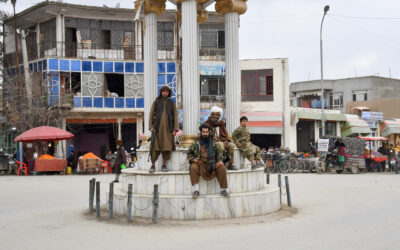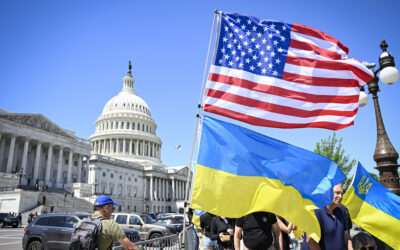
Russia’s Response to U.S. Aid: Shrugs, Disinformation and Warnings of Nuclear War
SUBSCRIBER+ EXCLUSIVE REPORTING — Russia’s reaction to the new infusion of U.S. aid for Ukraine has ranged from shrugs to fury, from warnings of nuclear […] More
After a short trip to Pakistan last week, I return to Washington convinced that the Trump administration’s new coercive approach toward Islamabad is working, at least in the narrow sense that it has grabbed the attention of Pakistani decision-makers and forced them to take notice of U.S. demands.
So far, the core elements of the approach include tough talk and tweets by President Donald Trump, a suspension of military assistance, and most recently, a diplomatic move to place Pakistan on a “gray list” at the last meeting of the multilateral Financial Action Task Force.
For a Trump administration that is too often adrift, divided, or inept, this coercive effort should be appreciated as a rare foreign policy achievement. When it comes to Pakistan, U.S. policymakers across different agencies and departments have been remarkably united and consistent even in the face of Pakistani intransigence and probing.
As compared to previous administrations, the Trump team has also been crystal clear about its demands. The familiar Pakistani claim that “we don’t really know what you Americans want from us because we hear different messages from different parts of the U.S. government” now rings hollow. Senior U.S. officials have also put in a lot of time on the ground; their visits were described to me by Pakistanis as a “parade” of American national security leaders.
Even the insanity of our president has been used to its greatest strategic effect. Pakistanis have to take seriously the possibility that Trump will continue to squeeze Pakistan even if a coercive approach risks backfiring on the United States. Whereas during the Obama years Pakistan’s leaders would attempt to use America’s rationality and liberal values to stymie Washington’s toughest threats, playing to our “better angels” and noting how we all stand to lose from a ruptured relationship or a failed Pakistan, now Pakistanis legitimately fear that such appeals hold no currency in the White House. They see in Trump a dangerous crusader who exhibits all the worst tendencies of the George W. Bush administration, and who is even more insensitive to any pain he inflicts on others, especially Muslims.
Not surprisingly, Pakistani officials have responded to U.S. coercive policies with anger, frustration, and claims that Pakistan is strong, resilient, and determined enough to withstand any American bullying. Perhaps only in the past few weeks have they entered a phase of more serious contemplation and dialogue, although even that is difficult to know for sure.
Pakistani officials now claim that they are addressing U.S. concerns, and American officials (including CENTCOM Commander General Joseph Votel) confirm that there may be tiny hints of progress. Although the details of sensitive U.S.-Pakistani discussions have not been made public, it is fair to conclude that the U.S. side shared a specific list of demands in the form of actions Pakistan should take against members of the Taliban, Haqqani network, and Lashkar-e-Taiba, and Pakistan’s military is responding to some of them, contesting some, and ignoring others, as reported by The Cipher Brief.
Pakistan’s army chief, General Qamar Javed Bajwa, has come out with forceful statements about the need to combat all militant groups on Pakistani soil, but anyone who has followed the relationship for any length of time has learned to ignore such claims and focus on concrete actions.
In sum, we are now witnessing the latter stages of an opening bid in a coercive negotiation with Pakistan. Washington made its move. So the question is—what happens next?
For starters, we should rule out the possibility that Pakistan will acquiesce fully to U.S. demands and take an about-face on the Haqqani Network and Lashkar-e-Taiba. That will take a lot more than a tweet, some aid suspensions, clever diplomacy and an expanded bombing campaign in Afghanistan. A grand “strategic shift” by Pakistan – the complete renunciation of proxy fighters that have been Islamabad’s preferred tools for projecting influence in the region for decades – is not in the cards, not now, and perhaps not ever.
So the most likely outcome is that Pakistan will play for time. As seen from the Pakistani military’s perspective, this isn’t a dumb move. At the moment, the Pakistani army is about as secure and comfortably in charge of its state as at any time since the Musharraf era. That the army’s power is exercised from behind the scenes does not make it any less potent. With that context, the army can afford to wait.
And who can say for sure what the next year of Trump’s circus will bring? The current U.S. policy consensus might not hold as Trump fires members of his national security team. Setbacks in Afghanistan could lead the president to reassess his current strategy formulated with input from National Security Advisor Lt. Gen. H.R. McMaster, now-departed Secretary of State Rex Tillerson, and Pentagon chief Jim Mattis.
If, for instance, Trump decides to go with his gut instinct, he could shift gears and withdraw all, or nearly all, U.S. forces from Afghanistan. Under such circumstances, it would be impossible for the United States to convince Pakistan of the need to curb its Afghan Taliban proxies.
If Pakistan chooses to play for time, it would not look like stonewalling. To the contrary, Pakistan’s leaders would aim to deliver just enough to minimally satisfy U.S. demands and avoid provoking the Trump monster. Actually, what we see at the moment looks a lot like that.
But playing for time exposes Pakistan to two main risks. First, it will be very hard for Pakistanis to titrate just how much action is needed to placate Washington. Who can say when Trump will lose his patience and raise the pressure? Subsequent steps in U.S. escalation could include blocking Pakistani requests for new IMF loans, which would send the economy into a precarious state.
On the military side, Washington could extend its air campaign against the Taliban into Pakistani territory. Such risky moves risk Pakistani counterpunches, like the closure of U.S. supply routes to Afghanistan. Such steps might not immediately rupture the U.S.-Pakistan relationship, but they would certainly force both sides to reconsider their positions and assess what they value most.
Pakistan also runs a second risk: the United States could give up on its strategy of coercion as a means to altering Pakistani politics and shift to punishment as its own end. For instance, if Pakistan’s obstruction is perceived by the White House as the cause of a politically embarrassing failure in Afghanistan that precipitates a U.S. military withdrawal, an angry Trump administration could lash out at Pakistan merely to assign blame and teach Islamabad a lesson. Washington could label Pakistan a “State Sponsor of Terrorism,” impose comprehensive sanctions, and consign Pakistan to a very difficult place in the international community.
Perhaps most threatening, from Pakistan’s point of view, would be how such a scenario would accelerate the strategic convergence between the United States and India.
One realistic, and likely more constructive, alternative strategy for Pakistan would be to alter the present terms of negotiation by tendering its own clearly articulated counteroffer. For years, U.S. officials have wished that Pakistan’s leaders would enumerate their own interests in Afghanistan in a way that could open the door to actual, serious bargaining. The Obama administration struggled with then-army chief General Ashfaq Kayani to explain what he really wanted from America. Unfortunately, his responses read like a laundry list of impractical demands and proved more frustrating than edifying.
Admittedly, there are reasons to doubt that Pakistan’s current chief would do much better. That said, my recent conversations in Islamabad offer some hope that the essence of U.S. and Pakistani goals in Afghanistan are not fundamentally incompatible, at least when they are boiled down to their bare essences.
On our side, we know that at this stage in the 17-year conflict, Washington basically wants to remove itself from a war without humiliation and without inviting a significantly reconstituted risk of international terrorism. Presumably, for its part, Pakistan mainly wants to keep Afghanistan from becoming a bastion of anti-Pakistan (read “India-backed”) forces. Nearly all the rest, as they say, is commentary.
Seeking ways to satisfy these bottom line goals would be a worthy starting point for bilateral talks and the best possible next step for both sides. This does not mean U.S. officials should let up the coercive pressure, but only that they should welcome such an overture from Pakistan if it is offered.
Related Articles

SUBSCRIBER+ EXCLUSIVE REPORTING — Russia’s reaction to the new infusion of U.S. aid for Ukraine has ranged from shrugs to fury, from warnings of nuclear […] More

SUBSCRIBER+ EXCLUSIVE REPORTING — When Chinese President Xi Jinping came to San Francisco last November to meet with President Joe Biden, Chinese pro-democracy activists in […] More

SUBSCRIBER+EXCLUSIVE EXPERT PERSPECTIVE — More than two years after its withdrawal from Afghanistan, the U.S. still does not have a clear way forward in the […] More

SUBSCRIBER+ EXCLUSIVE REPORTING — Ukrainians greeted Saturday’s long-awaited House passage of $60.8 billion in aid with justifiable jubilation. For months, their soldiers, civilians, and political […] More

SUBSCRIBER+ EXCLUSIVE REPORTING — A race for control of space is underway, and just as on earth, the U.S. and China are the top competitors. […] More

SUBSCRIBER+ EXCLUSIVE REPORTING — For nearly a week, the Middle East and much of the world were on a knife’s edge, waiting for a promised […] More
Search